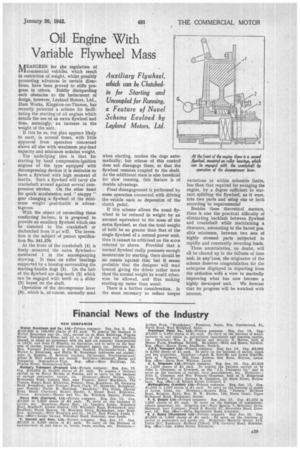Oil Engine With Variable Flywheel Mass
Page 31

If you've noticed an error in this article please click here to report it so we can fix it.
Auxiliary Flywheel, which can be Clutchedin for Starting and Uncoupled for Running, a Feature of Novel Scheme Evolved by Leyland Motors, Ltd.
UrEASURES for the regulation of 1.ficommercial vehicles, which result in restriction of weight, whilst possibly promoting advances in certain directions, have been proved to stifle progress in others, Boldly disregarding such obstacles to the betterment of design, however, Leyland Motors, Ltd., Ham Works, Kingston-on-Thames, has recently patented a scheme for facilitating the starting of oil engines which entails the use of an extra flywheel and thus, seemingly, an increase in the weight of the unit.
If this be so, the plan appears likely to meet, in normal times, with little approval from operators concerned above all else with maximum pay-load capacity and minimum unladen weight.
The underlying idea is that for starting by hand compression-ignition engines of the type equipped with decompressing devices it is desirable to have a flywheel with high moment of inertia. Such a flywheel will carry the crankshaft around against several compression strokes. On the other hand for quick acceleration and " snappy " gear changing a flywheel of the minimum weight practicable is advantageous.
With the object of reconciling these conflicting factors, it is proposed to provide an auxiliary flywheel which can be clutched to the crankshaft or declutched from it at will. The invention is the subject of patent specification No. 541,270.
At the front of the crankshaft (4) is freely mounted the extra flywheel— numbered 1 in the accompanying drawing. It runs on roller bearings supported by a housing surrounding the starting-handle dogs (5). On the hub of the flywheel are dog-teeth (2) which can be engaged with teeth on a slider (3) keyed on the shaft.
Operation of the decompressor lever (6), which is, of course, normally used when starting, meshes the dogs automatically, but release of this control does not disengage them, so that the flywheel remains coupled to the shaft. As the additional mass is also beneficial for slow running, this feature is of double advantage.
Final disengagement is performed by some operation connected with driving the vehicle such as depression of the clutch pedal.
If this scheme allows the usual flywheel to be reduced in weight by an amount equivalent to the mass of the extra flywheel, so that the total weight of both be no greater than that of the single flywheel of a normal power unit, then it cannot be criticized on the score referred to above. Provided that a normal flywheel really possesses enough momentum for starting, there should be no reason against this; but it seems probable that the designer will tend toward giving the driver rather more than the normal weight he would otherwise be allowed, and thus making starting-up easier than usual.
There is a further consideration. Is the mass necessary to reduce torque variations to within tolerable limits, less than that required for swinging the engine, by a degree sufficient to warrant splitting the flywheel, as it were, into two parts and using one or both according to requirements?
Besides these theoretical matters, there is also the practical difficulty of eliminating backlash between flywheel and crankshaft while maintaining a clearance, amounting to the barest possible minimum, between two sets of highly stressed parts subjected to rapidly and constantly reversing loads.
These uncertainties, no doubt, will all be cleared up in the fullness of time and, in any case, the originator of the scheme deserves congratulation for the enterprise displayed in departing from the orthodox with a view to markedly improving what has now become a highly developed unit. We forecast that its progress will be watched with interest.




















































